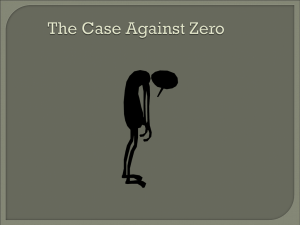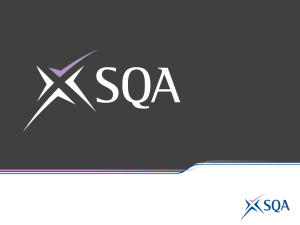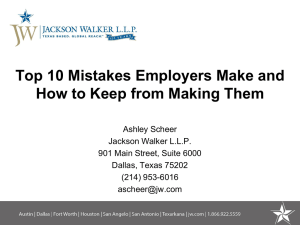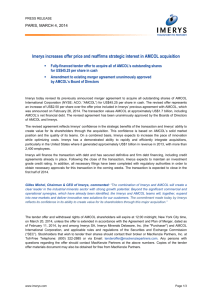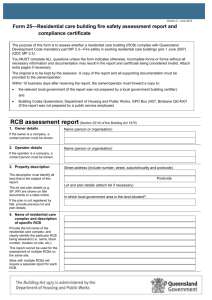Failing firm defence - Competition Law Association
advertisement
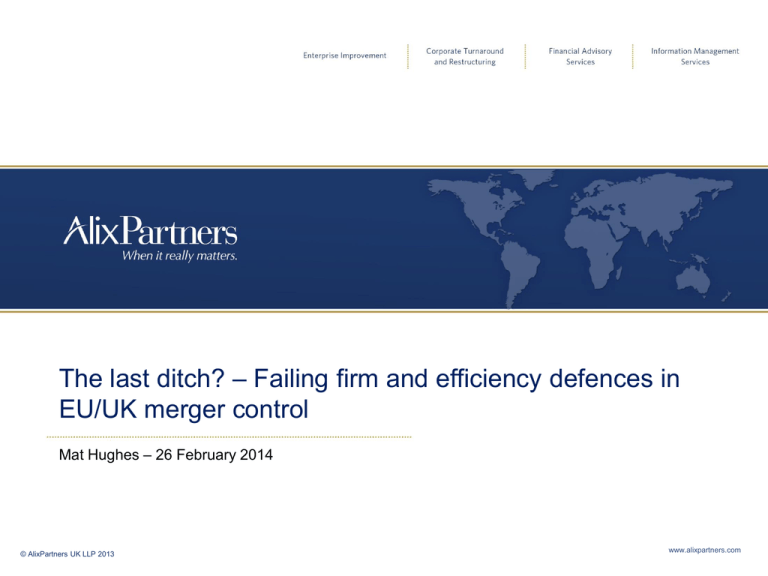
The last ditch? – Failing firm and efficiency defences in EU/UK merger control Mat Hughes – 26 February 2014 © AlixPartners UK LLP 2013 www.alixpartners.com Contents The failing firm defence - Do you feel lucky? Efficiencies – Mission impossible? Case study: Royal Bournemouth and Christchurch/ Poole (2013) Case study: CC Imerys/Goonvean (2013) Conclusions www.alixpartners.com 2 Failing firm defence (I) When is an otherwise anti-competitive merger OK? “Failing firm” defence means no SLC or SIEC (exiting-rationalising business defence): - firms might also be “flailing”, reducing concerns merger effects must be judged by reference to competition absent merger (counterfactual) May also be relevant to: - de minimis exception in UK (e.g. OFT Midland General Omnibus/Felix Bus Services (2012)) remedies (alternative purchaser?) merger benefits (absent merger what would happen to supply costs/output?) barriers to entry (watch consistency - entry likely/profitable?) Do you feel lucky? From 2010-13: ‒ 23 Phase II EUMR decisions from 2010-13, and only 8 unconditional clearances (35%) and two on the basis of failing firm (2013: Nynas/ Shell and Olympic/Aegean (II)) ‒ 29 CC reports from 2010-13 (plus 1 water), and 18 unconditional clearances (62%!). Of these: ‒ two failing firm (Optimax/Ultralase (2013) and Sector Treasury Services/Butler (2011)) ‒ Imerys/Goonvean (2013) failing product plus limited duration of concerns, and no SLC in McGill/Arriva Scotland West (2012) due to expectation of declining competition and threat of entry www.alixpartners.com 3 Failing firm defence (II) Criteria EU UK Exit – financial difficulties (application to banks/state hospitals) No less anti-competitive purchaser Assets inevitably exit market Exit – through failure, but also strategy change Ditto (Eurotunnel/Sea France (2013)) Even if exit, look at distribution of sales (could small players grow?) Surprise! Watch out for failing firm “offence”: - - the overlaps with businesses closed by seller, i.e. was closure due to sale of other business thus leading to anti-competitive effects? issue in 2011 in Stena/DFDS Irish Ferries and Ratcliffe Palfinger/Ross & Bonnyman, but (on facts) CC accepted closures not due to merger What evidence do you need? www.alixpartners.com 4 Efficiency defence Really? EU: efficiencies may offset anti-competitive effects UK: three “bites at cherry” (enhance rivalry (PF Tradebe/Sita (2014)); exception to refer (1 marginal), 2 cases influenced CC remedies) Closest EU TNT/UPS (2013) - prohibition decision! Annual cost savings €400-550m in three main areas: - management/administrative overheads ground transportation costs air network. EC estimated pass on and compared with the price increases predicted by its price concentration model (prices higher where fewer rivals…model submitted by parties) Customer efficiencies outweigh price rises in 15/29 countries (based on market shares, FedEx presence and expansion plans, bidding data) Nynas/Shell only EU case where efficiencies were a contributory factor in clearance decision, linked to failing firm (closure = higher import costs) plus lower variable costs www.alixpartners.com 5 NHS Hospital mergers Royal Bournemouth and Christchurch/ Poole (2013) merger prohibited. SLC 2131% of each hospital’s clinical income (much smaller in Akzo Nobel/Metlac (2012)) Proposition: we can’t afford duplication and merger benefits mainly where SLC No RCB found. Why, surely good? No presumptions - law and experience US merger integration/expert witness experience Duty to consult = no detail/plan? CC no need consult/decide but - preferred proposal/evidence of need; groups to evaluate benefits; model of care; assess clinical benefits/dis-benefits plus financial/economic viability Likely with merger? Maternity unit start 16/17? Likely without? Cardiology rota? Dis-benefits from rationalisation? A&E/emergency surgery? Cost savings? If CC had found RCB, might still have prohibited www.alixpartners.com 6 CC Imerys/Goonvean Efficiency defence: - detailed efficiency analysis. Large due to proximity of parties’ pits, mixture of fixed/variable savings but also increasing output (access to lower cost reserves and increasing life of pits) CC: Efficiencies not rivalry enhancing: - rivalry against whom? efficiency plans assume 0% pass on (!) and paid out in purchase price (?), BUT higher output a RCB Variant of failing firm defence? GHL: cash (EBITDA) generative, and kaolin + aggregates profitable overall bar two years: “the board was unanimous in its view that it would seek to ensure that the company would survive, although the prospects for the next few years appeared poor.” K + A cash generative? Look at management accounts - costs rising faster than prices, and ROCE very low - limited positive cash flows due to no re-investment (replace when fail) - capex less than depreciation over last five years - now heavily loss making (customer loss/high cost), major capex, limited reserves (abandon less profitable tableware – complex!), pension deficit Rational investor? Exit now or when Greensplat fails? CC: When(?) Greensplat fails Proportionality and RCB: - Divestment (add assets/keep liabilities!) and 5 year price cap equally effective (not harming rivals/simple). But divestment mean loss of RCB across all markets which would be large relative to divestment benefits (CPM sales low % of total) www.alixpartners.com 7 Conclusions All cases turn on their facts – don’t rule out failing firm or efficiency arguments Four successful second stage, failing firm cases in 2013 (2 UK, 2 EU) Royal Bournemouth and Christchurch/ Poole (2013) - CC put out a press release at provisional findings stage: “Hospitals must now prove merger benefits” EU narrowed concerns in TNT/UPS due to efficiencies PF Tradebe/SITA rely on merger efficiencies as one factor as why not concerned by 3:2 merger Rationale should be part of story. E.g. why do you want to buy a failing firm? An obvious efficiency story in both Nynas and Imerys Key challenges are facts - Expert TRS and EI evidence is needed www.alixpartners.com 8 Global Locations Thank you! Boston Chicago Dallas Detroit Dubai Düsseldorf Hong Kong London One Boston Place Suite 4040 Boston, MA 02108 617.742.4400 300 N. LaSalle Street Suite 1900 Chicago, IL 60654 312.346.2500 2101 Cedar Springs Road Suite 1100 Dallas, TX 75201 214.647.7500 2000 Town Center Suite 2400 Southfield, MI 48075 248. 358.4420 Office 101, Tower 2 Al Fattan Currency House P.O. Box 482093 Dubai Intl Financial Centre Dubai, United Arab Emirates +971.4.704.6000 Hofgarten Palais Bleichstraße 8 – 10 40211 Düsseldorf Germany +49.211.97.55.10.00 Suite 1802 LHT Tower 31 Queen’s Road Central Hong Kong +852.2236.3500 20 North Audley Street London W1K 6WE United Kingdom +44.20.7098.7400 Los Angeles Milan Corso Matteotti 9 515 S. Flower Street 20121 Milan Suite 3050 Italy Los Angeles, CA 90071 +39.02.360.12000 213.437.7100 © AlixPartners, LLP, 2012 Munich Mauerkircherstr. 1 a 81679 München Germany +49.89.20.30.40.00 New York Paris San Francisco Shanghai Tokyo Washington, DC Marunouchi Building 33F 40 West 57th Street 49/51 Avenue George V 580 California Street Suite 6111 1999 K Street NW 75008 Paris 2-4-1 Marunouchi Suite 2050 Plaza 66 Building I New York, NY 10019 Suite 750 France Chiyoda-ku San Francisco, CA 94104 1266 Nan Jing West Road 212.490.2500 Washington, DC 20006 +33.1.76.74.72.00 415.848.0283 Shanghai, 200040 China Tokyo 100-6333 Japan 202.756.9000 +81.3.5533.4800 +8621.6171.7555


